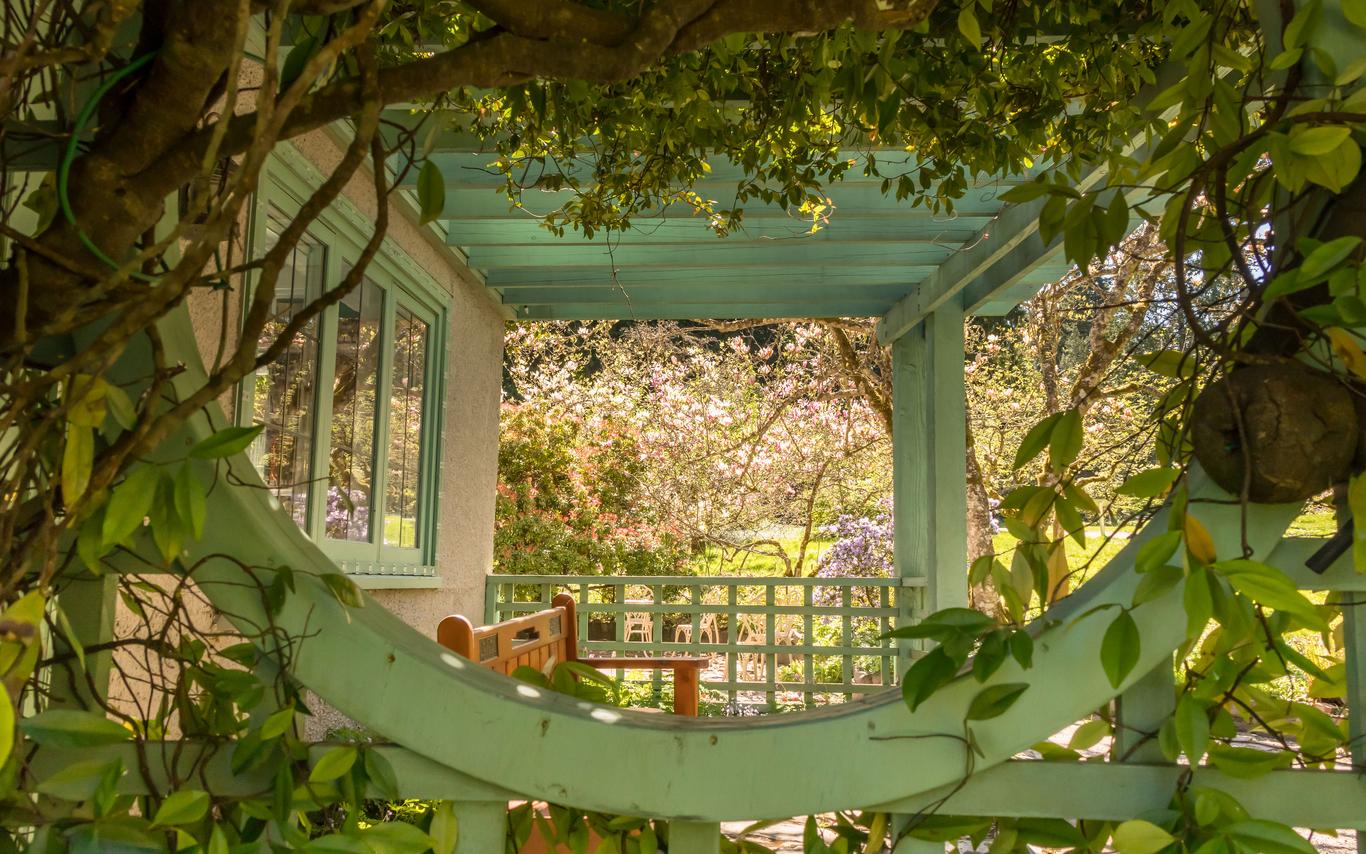The Woodland
Our property is located within the coastal Douglas-fir biogeoclimatic zone, creating the perfect grounds for towering Douglas-fir, Western redcedar and Grand fir to dominate and thrive. However, climate change and logging have taken their toll, leaving very few old-growth forests remaining. As a result, Milner Gardens & Woodland holds conservation of the area in extreme priority.
Forests are always changing. This woodland is the product of contrasting ecological forces: disturbance and recovery. Events such as wildfires or windstorms can be destructive, but such events have always occurred throughout history, and therefore, the species of the forest have evolved ways to recover after a natural disturbance.
The death of a tree isn’t the end. Alive or dead, standing or fallen, large trees always play an important role in the forest. These standing dead trees, called snags, eventually fall to the forest floor, becoming nurse logs. Nurse logs provide a hospitable habitat for new trees, shrubs, fungi and ferns to grow on, and animals to live in. With the fall of a tree, more sunlight can reach the forest floor, allowing shrubs and herbs that can’t live under a thick canopy of a forest to thrive.
We encourage you to stroll the East or West Trails, take a deep breath and soak in the health benefits of forest bathing.

The Gardens
"The moods of the gardens are limitless. Each season, each time of day holds a hidden treasure". – Margaret Cadwaladr, In Veronica’s Garden
At 45 years old, on her second marriage and restarting her life in Canada, Veronica Milner was forced to develop a lifestyle far from the British aristocratic society she was born into. She battled homesickness by throwing herself into a project that would keep her impassioned for the remainder of her life. Taking control of her surroundings and incorporating pieces of her past, she was able to transform the Milner estate into a Canadian adaptation of an English woodland garden, or ‘wild garden’ inspired by William Robinson. The main premise: natural, not manicured.
She spoke about the garden with the language of an artist. With no formal training in horticulture or landscape design, she relied on the artistic principles of painting and composition to create a place of serenity, elegance, rhythm and harmony. Although she was an avid painter, she believed gardening to be the highest form of art.
It was her intention that the gardens be allowed to grow, creep and crawl toward the light breaking through the forest canopy. That here, things are encouraged to follow their natural course. That each corner brings new vistas, and each season brings new discoveries, because, as she would say, ‘gardens must be, above all, for wandering’.
The garden lies on the sheltered eastern shore of Vancouver Island and is protected from severe weather conditions sweeping in from the Pacific Ocean by Mt. Arrowsmith to the west, and the multi-layered forest canopy casts a dense shade over much of the garden area. The Gardens are thoughtfully designed to balance an extensive collection of rare rhododendrons with native plants and towering Douglas-firs, and are graciously maintained by a dedicated team of volunteers alongside our Lead Horticulture Coordinator.
Bald eagles patrol the beach below and nest in the comfort of the treetops above, while blue herons fish the shore and purple finches shelter in the camellias lining the house. If you're lucky, you may even spot whales off the Grand Lawn!
View a comprehensive list of our plant collection here.

The Greig Rhododendron Species Garden opened to the public in April 2018 and is located beyond the Reflecting Pool along the path to the Viewing Platform in Milner Gardens & Woodland. This garden is a partnership between Vancouver Island University's Milner Gardens & Woodland and the five Vancouver Island chapters of the American Rhododendron Society in Qualicum Beach (Mount Arrowsmith), Nanaimo, Courtenay (North Island), Cowichan Valley, and Victoria, as an education project to show the diversity of the genus Rhododendron. The garden is designed in six global geographic areas: Szechuan, Yunnan, Himalayas, Northeast Asia, Europe and North America.
The Greig Rhododendron Species Garden was named in honour of Ted and Mary Greig, pioneers in their field, who created many of the early hybrids found in Milner Gardens & Woodland.
"Take a stroll through one of the most unique gardens in Canada!" - watch this Shaw Spotlight video: 'A Walk Through the Rhodos - The Greig Rhododendron Species Garden'!
This garden also includes an area to nurture endangered species along with a section to represent plants that are parent to many of the Greig hybrids found in the rest of the garden. These species represent the original Rhododendrons with more than 1,000 species in the world. The ancestry of most hybrids can be traced to species Rhododendrons.
The Rhododendron Species Garden has about 230 species Rhododendrons along with companion plants and with plans to add more as they become available. These species Rhododendrons were sourced from private donors and the Rhododendron Species Foundation in Federal Way, Washington. In all cases, provenance is assured with these species Rhododendrons accessioned to the Milner Gardens & Woodland collection.
Funding for the Greig Rhododendron Species Garden has been provided by Vancouver Island University and the five Vancouver Island Chapters of the American Rhododendron Society along with financial contributions from private donors and grants from the American Rhododendron Society. The entire project from original design and hardscape, to the clearing and planting is the work of the volunteers and staff from the Rhododendron Societies and the Milner Gardens & Woodland community.
Veronica Milner was introduced to rhododendron hybridizers Ted and Mary Greig in 1954 and in the following 15 years planted over 500 rhododendrons which are now the foundation of our woodland Gardens.
Milner Gardens & Woodland received an initial generous grant from the American arm of the Stanley Smith Horticultural Trust, an organization based in the United Kingdom that funds projects pertaining to the preservation and development of public gardens. Further donations were also received from the Mount Arrowsmith Rhododendron Society, and the Cowichan Valley Rhododendron Society, along with Jim and Jean Greig. This funding supports our endeavor to identify, label and develop interpretive signage for our rhododendrons, to allow the visiting public to learn more about our unique collection.
Milner Gardens has over 400 rhododendrons currently accessioned, with more than 150 of these unidentified or carrying names from old plant tags that require verification. Many of the old plant tags are illegible or engulfed in the bark of specimens, requiring some sleuth work to ascertain what the label may have read.
We used different methods to tackle the enormous job of finding the lost names of our 'rhodies'.
First, we invited a number of rhododendron experts, from B.C., Washington and Oregon, to visit the Gardens to view our collection and share their expertise. We also have limited historical documentation available to us including a planting map and invoices from the Greig’s Royston Nursery from the 1960’s. These documents give us the advantage of narrowing the potential names available – its easier to choose from 500 possible names than from the thousands of rhododendrons that exist in cultivation today.
The most painstaking but accurate method of identification involves using botanical keys. ‘Keying out’ a specimen requires closely analyzing flower parts and leaves for characteristics such as size and shape, as well as microscopic details like minute hairs and glands. It’s a very detailed, methodical and fascinating process.

